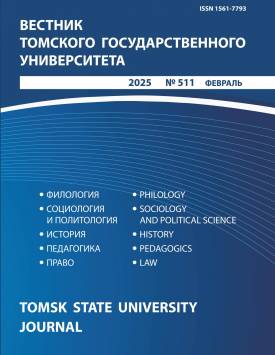The horse and the image of the horse in the culture of the Altaians
In this article, the author conciders the dynamics of the cult of the horse in the traditional culture of the Altai ethnic group in the relationship of the ritual sphere and the production system. The works of V. V. Radlov and A.V. Anokhin, scientific travelers of the 19th and 20th centuries, were used, in particular, ethnographic subj ects related to the description of the Altai horse and its role in the ritual sphere, including the rite of sacrifice,. The texts of the largest tales of the Altai heroic epic - "Madai-Kara" and "Ochy-bala", recorded in 1963 by S.S. Surazakov from the famous storyteller A.G. Kalkin, are analyzed, as well as small folklore genres: riddles, proverbs, and good wishes. In the course of the analysis, the author relied on the conclusions of her predecessors. The cult of the horse among the Altaians is considered in articles by L.P. Potapov, V.M. Mendesheva, and L.V. Chanchibaeva; the topic of the development of Altai horse breeding is presented in articles by L.N. Muzikova, T.V. Lobanova, V.A. Trushnikov, A.A. Tish-kin, and others. During the study, the author analyzed field materials collected in the Ust-Kan and Ongudai Districts of the Altai Republic in 2022-2023. The data of regional periodicals are involved: newspapers Zvezda Altaya [Star of Altai] and Kan-Charas. A systematic method was used, which helped show the role of the horse in all aspects of the functioning of traditional culture - the worldview, the ceremonial sphere, and the subsystem of production. The synchronic method was used to study the cult of the horse in various regions of the Altai Republic in order to identify common trends. From the standpoint of the historical approach, the dynamics in the existence of the cult of the horse and the development of horse breeding among the Altaians are traced. In the course of the study, the high semiotic status of the horse was determined, through which the sacred symbols of traditional culture are reflected. The plots related to the horse are highlighted and the ambiguity of its image is shown. It was established that the heroic horse is connected with two spheres of existence - natural and human; it combines both, and in both it occupies a dominant position, correcting natural phenomena, the mind, and human actions. It is shown that through the image of a horse, the mytho-poetic consciousness of the Altaians expresses the nature and the person themselves. The image of a horse in small folklore genres is analyzed and the dynamics of the image compared to the heroic epic is traced. The modern forms of the ceremonial functions of the horse, actualizing protective and producing magic, are revealed. The modern horse breeding of the Altai people is considered as a basis for preserving the cult of the horse: the improvement of the Altai horse breed and the history of breeding the New Altai breed, the process of branding horses, developed terminology in relation to horses. The role of the horse as a factor of social prestige is revealed. Equestrian competitions are characterized from the point of view of modern forms of existence of the cult of the horse. The author declares no conflicts of interests.
Keywords
Altaians, worldview, horse, heroic epic, small folklore genres, rituals, horse breedingAuthors
| Name | Organization | |
| Charyshova Maria Yu. | National Research Tomsk State University | charyshovamaria@mail.ru |
References

The horse and the image of the horse in the culture of the Altaians | Vestnik Tomskogo gosudarstvennogo universiteta – Tomsk State University Journal. 2025. № 511. DOI: 10.17223/15617793/511/16
